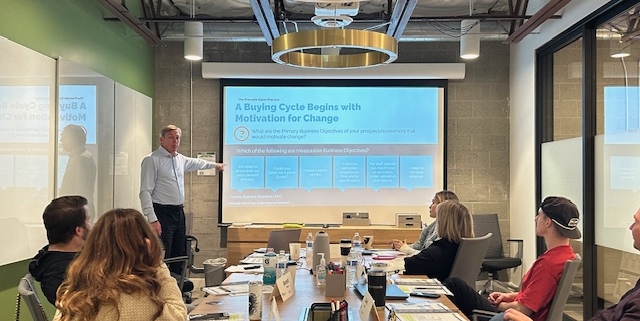This month I had the pleasure of visiting Columbia and Panama, my 59th and 60th countries. And also toured one of the modern marvels on this planet, The Panama Canal. Listen above for how this applies to sales success.
Archive for month: February, 2024
Have you ever spent several thousand dollars (and then some) on training only to see no change or short-term boosts at best? If your sales training is striking out, it’s probably due to a lack of prep and follow-up. There are ways to achieve long-term positive changes through training but you’ve got to know what you’re signing up for and consider some clear-cut strategies.
For starters, different types of training accomplish different goals. Over the years we’ve been hired by clients for one-hour kick-off motivational keynotes, three-day intensive sales process training and everything in between. We’ve learned a few things along the way including – sales training conducted as an “event” simply doesn’t work.
If your goal is to transform your organization so that it’s achieving goals like increasing sales or increasing profit margin, the training itself is only 10% of the overall process. To make your training investment stick, consider the following before you spend valuable dollars.
You Need an Implementation Plan. Start your transformation with the end in mind. What metrics will be used to measure the success of the salespeople, manager and related team member(s)? Will leadership hold them accountable for achieving these goals? For example, to achieve 10% growth in revenue you’ve calculated that each salesperson needs to meet with one additional qualified prospect per day. The skill being developed is new business development. How will you hold each person accountable for that number? The measure of success could be an email the salesperson sends to the customer that summarizes their meeting. This is an auditable measure that a manager and a manager’s manager can use. The email not only provides quantitative measurement, but the leaders, and even the CEO, can review the email and see the quality of customer interactions. How well was the new skill captured in the follow-up e-mail? Does this contact meet the defined metric of adding one new qualified prospect per day?
Have a Strategy to Reinforce and Coach Learned Skills.
Sales skills that are enhanced or gained in a training session are 80% forgotten after the first 30 days. Why? When not practiced or measured with a 3rd party, there’s often little to no change in behavior. The formula for reinforcement is: a) apply the learned skill b) share results with the coach and then c) reinforce the behavior. For coaching, first get attendees to apply new skills in the field. This could be verbal or written sales skills – but only introduce one skill at a time. Then it’s time to coach. Ask specific questions about the desired outcome. For the example above, did the salesperson meet (or converse) with one new, qualified prospect a day? Frame questions that help them understand what went well and where correction needs to happen. Next, ask them how they can improve their results. Effective coaches help people find their own answers. Finally, ask what would happen if the next time they tried … and then insert a specific recommendation. Reviewing a video of someone good at executing a skill is a way to fine-tune a new sales method. Rehearsing a future conversation with a recording is also a good practice.
When changes are reinforced, salespeople will remember how inspired and motivated they were at training. And with effective measuring, they’ll know these skills and behaviors will be recognized.
When I’m retained by clients to help their sales team, the first thing I do is to ask to interview their top performers. My purpose is to decode their selling DNA and identify the markers that make them successful.
Invariably, effective salespeople sell value, not solutions or services. They recognize that it’s the ‘why’ that resonates with buyers – the business value. Equally revealing is illustrating how today’s problems impact the overall bottom line. But selling value and the total cost of problems facing a customer is where many sales teams run into trouble.
Pinpointing and helping customers articulate these positions may not come naturally but it’s a necessary practice if you want to meet or beat your goals. Top performers use the following three tactics to draw out the answers to business value and the cost of challenges.
- Get to the cost of today’s problem. Buyers face a number of problems and challenges. Great salespeople help buyers define – in totality – all of the costs these problems bring. While costs may be non-monetary, such as frustration or low morale, the numbers that hit the bottom line are those that are heard by every person involved in the buying decision. Great sellers shape and frame conversations around the costs of the buyer’s problems. This is especially important if the solution’s value comes with a higher price tag. Early conversations around costs will help sell more and ensure that the necessary margins are hit in the end.
- Tell stories. Stories help buyers discover for themselves the problems that they are facing and the solutions they need. High achievers have several stories at the ready that they can tailor and share based on the buyer’s situation or desired outcome. When the conversation lulls and the buyer is unable to explain their problem, share a story! Start by framing who the experience is about. Then identify the problem, turning point and resolution. Buyers who hear successes and failures of industry peers become more willing to share details about themselves and have an easier time finding their voice. Stories not only get to problems, they also help describe how others use and derive business value from your products. Stories have purpose and great salespeople use them again and again.
- Summarize conversations in writing. This is a tactic that all sellers tell me they do, but few do it well. I sell my services to many companies in different industries. I constantly refer to follow-up emails I’ve written after conversations. The emails sum up problems a client is facing and the associated costs, the solutions we discussed and their value, and of course, proposed next steps. These emails help the customer and I keep the focus on the problems we are trying to solve. Top performers don’t rely on memory. They simplify, write the plan down, share it with the customer and allow the customer to give feedback.
If you want to sell the business value your products bring, incorporate these techniques and the process will be habit in no time.
My travels for business and adventure continue, and I am pleased to be traveling to Cartagena, CO and Panama City, Panama from Feb 7 to Feb 16th.
Do you live in or near these exciting cities? Or who do you know that does who would enjoy a Global Sales conversation? I would welcome a chance to meet. You can message me below or reach me on WhatsApp at +1 858 518-7039
It’s always refreshing to understand the buying behaviors in the countries we travel and work in. This will be countries 20 and 21 for Flannery Sales Systems and 59 and 60 for me on a personal level.



